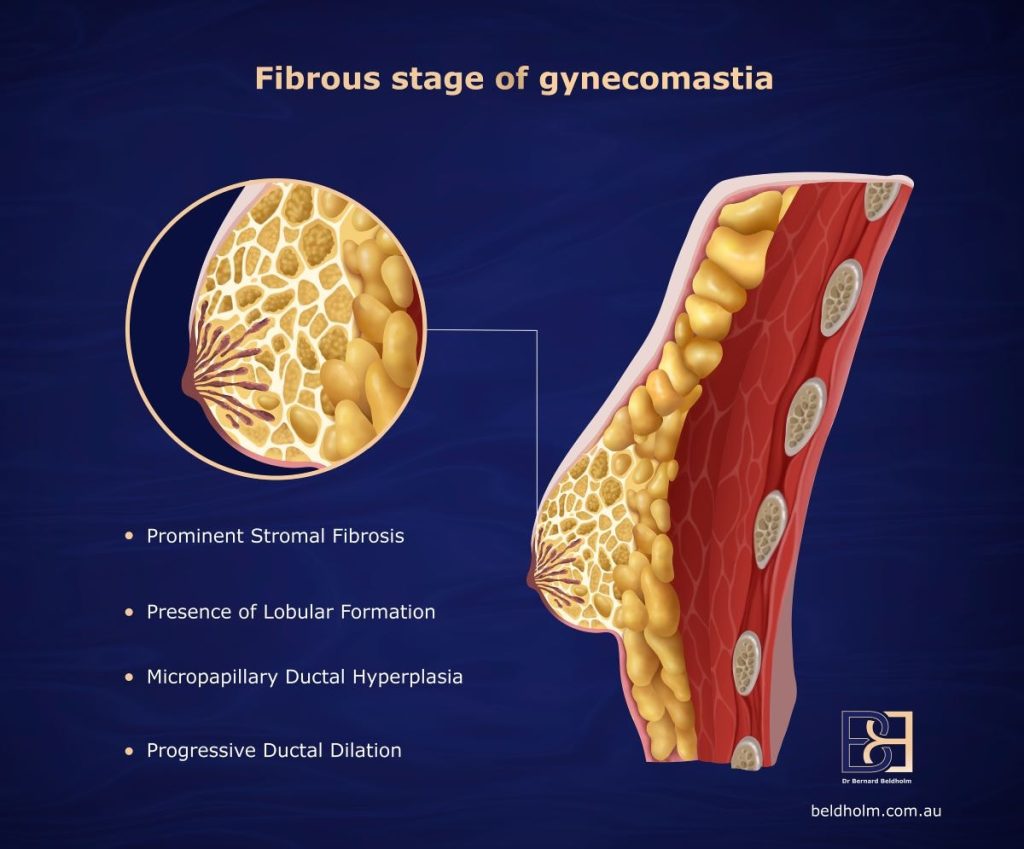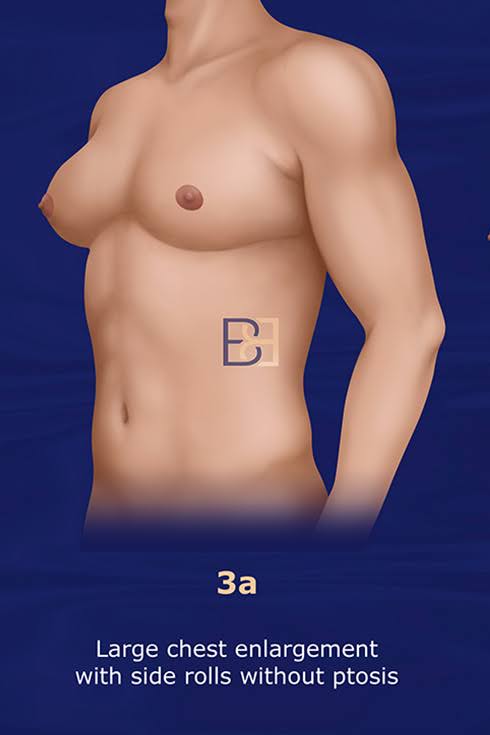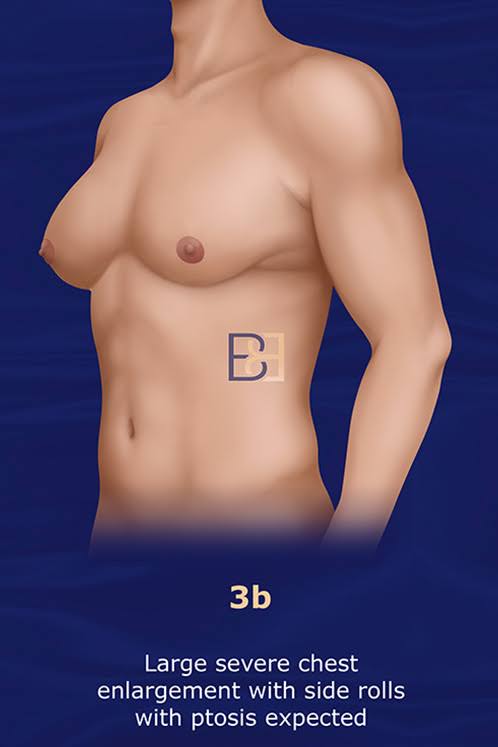Gynaecomastia, the enlargement of male breasts, is a common, normally benign, and frustrating condition that occurs in men of all ages. In fact, a recent study of adult men showed that 36% of young men and 57% of older men have some form of Gynaecomastia, indicating that as many as one in every three adult men and one in every two elderly men suffer from this condition.

Book your appointment online now
Gynaecomastia is commonly classified into grades based on the severity of the condition. From puffy nipples and minor enlargement to severe with ptosis, Gynaecomastia affects males from puberty to senior years.
While the word “Gynaecomastia” is frequently used as a blanket term when referring to this condition, some forms of this issue fall under the category of “true Gynaecomastia,” while others are considered “PseudoGynaecomastia.”
“True Gynaecomastia” and “pseudoGynaecomastia” are similar in that they both involve an enlargement of the male breast. They differ, however, in their causes and composition.
True Gynaecomastia
This condition is caused by an overdevelopment of glandular breast tissue that is often triggered by a hormonal imbalance, where oestrogen levels become elevated relative to testosterone. Puberty, ageing, use of certain oral medications (e.g., steroids, antidepressants), or conditions affecting hormone levels, such as hyperthyroidism.
Generally, with true Gynaecomastia, the chest area takes on a prominent appearance due to the growth of glandular tissue beneath the nipple, with the nipple having a rubbery feel.
PseudoGynaecomastia
Caused by an accumulation of fat in the chest area, Pseudo-Gynaecomastia is more often related to weight gain or obesity. Unlike true Gynaecomastia, this variation of the condition presents with chest enlargement that is softer and more diffuse, as it is primarily fat tissue.
Though some weight lifting techniques and exercises that tone the chest can help ** this condition in some men, the most effective treatment is liposuction.
Grading Systems for gynaecoamstia
Gynaecomastia can be classified using various grading systems to determine the severity of the condition and guide treatment options ranging from less invasive to more complex. Surgeons refer to these systems, from the earliest, (e.g., Simon), to more modern (e.g., Barros), when determining the best surgical approach.
Punia and Gupta Classification (2023)

Developed by Sudhanshu Punia, MBBS, DNB and Amit Gupta, the Punia and Gupta classification system was created to ** limitations in previous classification methods, offering a more detailed and practical framework for ** a wider range of patient presentations.
Though Gynaecomastia can vary widely from patient-to-patient, earlier classification systems focused on volume or size alone, without considering factors like skin elasticity, glandular tissue composition, or the presence of ptosis (**). This system allowed for classification for patients that were previously unclassified such as those with puffy nipples.
This new classification for Gynaecomastia was intended to be a **, straightforward, and comprehensive grading system that could help provide precise and predictable results and ensure patient **.
Placing the focus on breast enlargement and the presence of skin redundancy at different stages, Punia and Gupta Classification recognizes skin ** and excess at an earlier grade (Grade III), which is critical for deciding if the patient requires skin tightening along with tissue excision.
In addition, the basis for this new clinical classification for Gynaecomastia recognizes that treatment must ** the entire chest area and not just the breast.

Punia and Gupta Classification Grading System
Grade 1a: Puffy Nipple

- Presentation: Minor tissue growth primarily located around the areola, with no significant skin excess.
- Treatment: Gland excision through infra-areolar incision.
Grade 1b: Minor Breast Enlargement

- Presentation: Small Enlargement Without Skin Excess
- Treatment: Liposuction (around gland area) and gland excision through infra-areolar incision.
Grade 2a: Moderate Enlargement Without Skin Excess

- Presentation: Breast tissue extends beyond the areola, but there is no skin ** or excess.
- Treatment: Liposuction (around gland area and axilla) and gland excision through infra-areolar incision.
Grade 2b: Moderate Enlargement With Ptosis

- Presentation: Breast tissue extends beyond the areola with excess skin and **.
- Treatment: Liposuction (around gland area and axilla), gland excision, and U skin lift from supra-areolar approach.
Grade 3a: Enlargement Without Significant Ptosis

- Presentation: Breast tissue enlargement is more pronounced, with side rolls and excess skin but no significant ** (ptosis).
- Treatment: Requires both tissue excision and liposuction (around gland area and axilla) and gland excision through infra-areolar incision.
Grade 3b: Moderate Enlargement With Significant Ptosis

- Presentation: Breast tissue enlargement is more pronounced, with excess skin, side rolls, and with ptosis expected.
- Treatment: Requires both tissue excision and liposuction (around gland area and axilla), gland excision, and U skin lift from supra-areolar approach.
Grade 4a: Marked Enlargement With Significant Skin Excess and Ptosis

- Presentation: Severe Chest Enlargement without significant ptosis. May need a second stage for tackling excess skin or same-stage axillary roles excision
- Treatment: Complex procedures including gland removal, skin tightening, and nipple repositioning.
Grade 4b: Marked Enlargement With Significant Skin Excess and Ptosis

- Presentation: Severe Chest Enlargement without significant ptosis. May need a second stage for tackling excess skin or same-stage axillary roles excision
- Treatment: Complex procedures including gland removal, skin tightening, and nipple repositioning. Second stage mastopexy may be needed.
Advantages of the Punia and Gupta Classification System
New Classifications
The authors of the study believed that the existing Gynaecomastia classifications needed to be more detailed, as several key aspects were either misrepresented or not mentioned at all in earlier systems, which left them to be deemed “unclassified.”
Some cases of Gynaecomastia involve puffy nipples only, which earlier systems did not adequately **. This system is the first to include a classification for puffy nipples. Still, other cases, which involve significant asymmetry or severe forms of ptosis, were also not adequately classified in earlier systems. The Punia and Gupta Classification allows for more accurate categorization of these complex cases.
Holistic Approach
Traditional systems focused mainly on the size of the glandular tissue, while the The Punia and Gupta Classification System considers a more comprehensive range of factors, (e.g., the degree of ptosis, glandular and fat tissue proportions, quality of the skin).
Customization for Treatment
The Punia and Gupta Classification System provides a more tailored approach to classifying Gynaecomastia, which is critical for determining the most effective treatment options.
Final Note
The authors of this system conducted their study over a 24 month period at their Aesthetic Surgery Center in India, from May 2020 to May 2022, and included 1,571 patients ranging in age from 15 to 56 years.
Dr. Beldhom’s Thoughts on the Punia and Gupta Classification System
Dr Bernard Beldholm (MED0001186274) M.B.B.S B.Sc (Med) FRACS, a Registered medical practitioner, is an experienced specialist surgeon, focuses on body contouring surgery. Dr Beldholm has performed a range of cosmetic surgical operations over the last 15 years, with a current focus on post-weight loss concerns, including a wide range of Gynaecomastia patients.
Dr Beldholm has studied the various Gynaecomastia classification systems extensively, and has come up with the following conclusions about the Punia and Gupta system.
Dr. Beldhom agrees that there was need for a classification system that encompassed a wider segment of presentations such as puffy nipples, which none of the preceding systems covered.
Dr. Beldholm disagrees with the following points.
- There is no need to differentiate between 1b and 2a, as both need VASER liposuction and gland excision.
- As to the treatment recommendations for the higher grades, grade 4 requires skin excision with nipple areolar grafts to adequately ** the excess skin.
- Though not generally considered “real Gynaecomastia,” there is no mention of pseudo-Gynaecomastia in this study, even though it can look identical and have similar consequences to real Gynaecomastia and cause significant psychological consequences for patients.
Book your appointment online now
Resources
Punia, Sudhanshu, and Amit Gupta. “A New Clinical Classification for Gynaecomastia Management and Predictive Outcome.” Indian Journal of Plastic Surgery 56.04 (2023): 332-337.






